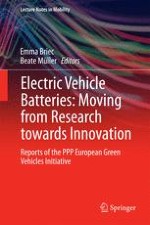This edited volume presents research results of the PPP European Green Vehicle Initiative (EGVI), focusing on electric vehicle batteries. Electrification is one road towards sustainable road transportation, and battery technology is one of the key enabling technologies. However, at the same time, battery technology is one of the main obstacles for a broad commercial launch of electric vehicles. This book includes research contributions which try to bridge the gap between research and innovation in the field of battery technology for electric vehicles. The target audience primarily comprises researchers and experts in the field.
